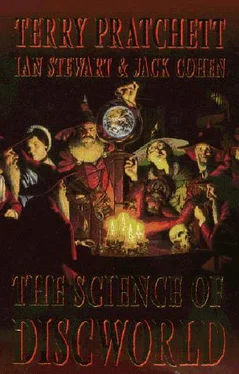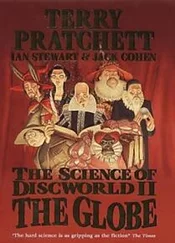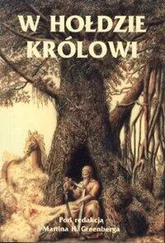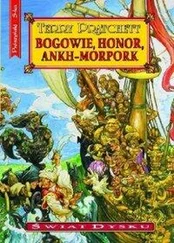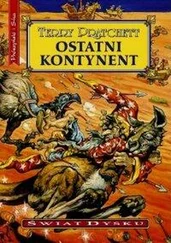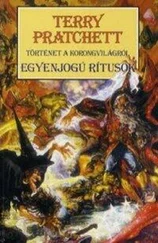Terry Pratchett - Science of Discworld
Здесь есть возможность читать онлайн «Terry Pratchett - Science of Discworld» весь текст электронной книги совершенно бесплатно (целиком полную версию без сокращений). В некоторых случаях можно слушать аудио, скачать через торрент в формате fb2 и присутствует краткое содержание. Жанр: Фантастика и фэнтези, на английском языке. Описание произведения, (предисловие) а так же отзывы посетителей доступны на портале библиотеки ЛибКат.
- Название:Science of Discworld
- Автор:
- Жанр:
- Год:неизвестен
- ISBN:нет данных
- Рейтинг книги:4 / 5. Голосов: 1
-
Избранное:Добавить в избранное
- Отзывы:
-
Ваша оценка:
- 80
- 1
- 2
- 3
- 4
- 5
Science of Discworld: краткое содержание, описание и аннотация
Предлагаем к чтению аннотацию, описание, краткое содержание или предисловие (зависит от того, что написал сам автор книги «Science of Discworld»). Если вы не нашли необходимую информацию о книге — напишите в комментариях, мы постараемся отыскать её.
Science of Discworld — читать онлайн бесплатно полную книгу (весь текст) целиком
Ниже представлен текст книги, разбитый по страницам. Система сохранения места последней прочитанной страницы, позволяет с удобством читать онлайн бесплатно книгу «Science of Discworld», без необходимости каждый раз заново искать на чём Вы остановились. Поставьте закладку, и сможете в любой момент перейти на страницу, на которой закончили чтение.
Интервал:
Закладка:
They went back to the sea.
The land animals had originally come out of the sea, despite the wizards' best efforts to stop them. Now a few mammals decided they'd be better off going back there. The wizards consider such a tactic to be a spineless piece of backsliding, giving up and going back home. Even to us it looks like a retrograde step, almost counter-evolutionary: if it was such a good idea to come out of the oceans in the first place, how could it be worthwhile to go back again? But the evolutionary game is played against a changing background, and the oceans had changed. In particular, the available food had changed. So in the mid-Eocene we find the earliest fossils of whales, such as the sixty-foot (20 m) long Basilosaurus, which had a pair of tiny legs at the base of its long tail. We've found fossils of its ancestors, and they really did look like small dogs.
The Mediterranean sea was dammed, Africa came into contact with Europe, and creatures previously confined to Africa spread into Europe, among them elephants, and apes. Horses evolved, as did true cats (such as the famous sabre-toothed tiger). By five million years ago, most of today's mammals were represented in recognizable form, and the climate had become similar to today's.
The scene was set for the evolution of humans.
Not that it had all been set up in order to lead to us, you appreciate. Our early ancestors just happened to be in a position to take advantage of the world as it then was. They did so.
We can trace the ancestry of modern mammals, indeed all living creatures that still exist today, by mapping out changes in their DNA. The rate at which DNA mutates, acquires random errors in its code, leads to a 'DNA clock' that can be used to estimate the timing of past events. When this technique was first discovered, it was widely hailed as a precise and therefore uncontroversial way to resolve difficult questions about which animals' ancestors were more closely related to what. It is now becoming clear that precision alone cannot provide definitive answers to such questions.
The issue of interpretation, what does this result mean?, can still be controversial, even if the result itself can be made precise. For example, S. Blair Hedges and Sudhir Kumar have applied the DNA clock to 658 genes in 207 species of modern vertebrates: rhinos, elephants, rabbits, and so on. Their results suggest that many of these lineages were around at least 100 million years ago, coexisting with the dinosaurs, though no doubt the early elephant and rhino ancestors were rather small. The fossil record agrees that there were mammals then, but not those. The molecular biologists claim that the fossil record must be misleading; palaeontologists are convinced that the DNA clock sometimes ticks faster and sometimes ticks slower. The debate continues, but for what it's worth, our money is on the palaeontologists.
One big surprise about mammal DNA is how much of it there is. You might expect a sophisticated creature like a mammal to be 'hard to build' and therefore require more DNA, just as the blueprint for a jumbo jet has to be more complicated than that for a kite.
Not so.
Mammals have less DNA, shorter genomes, than many apparently simpler animals, for example frogs and newts.
There's a good reason for this apparent paradox, and it illuminates the difference between DNA and a blueprint. DNA is more like a recipe, and a recipe that makes a lot of assumptions about what else you have in your kitchen, so that none of that needs to be spelled out in the recipe book. In essence, the kitchen for mammals has a really well controlled oven, capable of ensuring nice, even cooking temperature, so a whole lot of tricks about what to do if the temperature changes need not be mentioned. In the frog kitchen, on the other hand, the temperature goes up and down depending on the time of day and the weather, so the recipe has to deal with all contingencies, requiring more DNA code. By 'kitchen' here we mean the environment in which the embryonic animal has to develop. For a frog, the kitchen is a pond. For a mammal, the kitchen is mother.
Mammals evolved good temperature control, unlike the reptiles, they are warm-blooded, but what matters is not so much being warm, as being controllable. Frog DNA is full of genes for making lots of different enzymes, together with instructions along the lines of 'use enzyme A if the temperature is lower than 6°C, use B if the temperature is between 7°C and 11°C, use C if the temperature is between 12°C and 15°C ...' Mammal DNA just says 'Use enzyme X', knowing that mother will take care of temperature variations. Frog DNA is a rocket: mammal DNA is a space elevator.
How did this change take place? Perhaps when mammals first evolved, their DNA gained extra instructions, but after temperature control evolved, a lot of the DNA became redundant, and it either got dumped or got subverted to other uses. On the other hand, we have no idea what the DNA of early mammals actually looked like, maybe it was all shorter in those days, maybe today's frogs and newts have much more extensive recipes than ancient ones. But on balance it seems more likely that mammals just eliminated a lot of surplus instructions.
Modern technology uses the same trick. Because the machinery that makes today's consumer goods is extremely precise and accurate, those goods can be simpler than they were in the past. A soft drinks can, for example, is little more than a piece of aluminium that has been formed into a cylinder, with another flat bit on top to act as a lid, a weak line for the tab to tear along, and a ring (or nowadays a lever) attached to the tab. It replaces the bottle, which consisted of two or more bits of moulded glass 'welded' together, a metal cap, and a slice of cork. The simplicity of the can comes at a price: very careful control of the forming process.
There are many scientists who insist that an organism's DNA determines everything about it, even though it manifestly does not, and they argue that the mother's temperature-control system is included in her DNA recipe. This may well be true, but even if it is, 'this organism's' DNA has somehow migrated to another organism (mother, not her offspring). As soon as two generations are involved in implementing the genetic blueprint, a gap opens up into which things can be inserted that are not genetic at all. We've already mentioned several, for example prions in the reproduction of yeast.
Our mammalian ancestry may even be responsible for one of the more bizarre modern myths, persistent tales of people being abducted by aliens. Ufologists allege that one American in twenty now claims to have undergone such an experience (but they would, wouldn't they?). If true, this figure is a remarkable and not very happy comment either on the critical faculties of that great nation or on the habits of an unknown spacefaring species. Be that as it may, a lot of people are convinced that strange aliens, usually with big black eyes and pear-shaped heads like the ones in Close Encounters of the Third Kind, landed a UFO near them, loaded them on board, and took them for a flight round the solar system while carrying out weird experiments, often of a sexual nature, on them. After which they were calmly returned to the very spot from which they had been abducted, as if absolutely nothing had happened.
The first thing to say is that without doubt many of these experiences are false. Ianonce did a radio broadcast which included a woman who had undergone a convincing experience of being abducted, except that she knew she hadn't really been, because her family told her she'd been asleep beside the fire the whole time. Jack once met a woman who claimed that the aliens abducted her and took away her baby. So he asked a question that nobody else had thought to ask, the woman included: 'Were you pregnant?'
Читать дальшеИнтервал:
Закладка:
Похожие книги на «Science of Discworld»
Представляем Вашему вниманию похожие книги на «Science of Discworld» списком для выбора. Мы отобрали схожую по названию и смыслу литературу в надежде предоставить читателям больше вариантов отыскать новые, интересные, ещё непрочитанные произведения.
Обсуждение, отзывы о книге «Science of Discworld» и просто собственные мнения читателей. Оставьте ваши комментарии, напишите, что Вы думаете о произведении, его смысле или главных героях. Укажите что конкретно понравилось, а что нет, и почему Вы так считаете.
